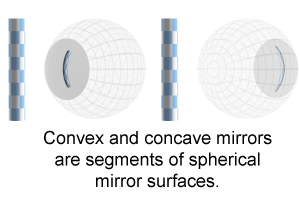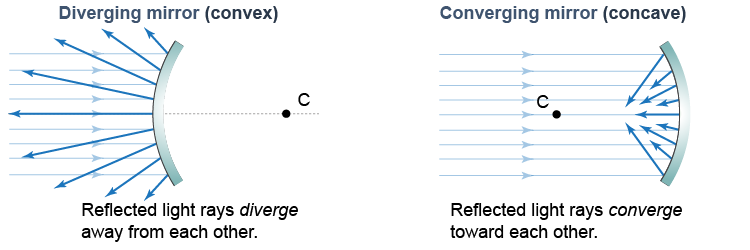|
 The image in a flat mirror is a life-size, undistorted “picture” of the original object. The image in a curved mirror may be upside-down, magnified, or distorted in other ways. The simplest curved mirror to analyze has the shape of a section of a sphere. Think of a shiny, hollow ball—and then cut off a piece of it. A convex mirror has a reflecting surface that bulges outward. A concave mirror has a reflecting surface that cups inward, like a bowl.
The image in a flat mirror is a life-size, undistorted “picture” of the original object. The image in a curved mirror may be upside-down, magnified, or distorted in other ways. The simplest curved mirror to analyze has the shape of a section of a sphere. Think of a shiny, hollow ball—and then cut off a piece of it. A convex mirror has a reflecting surface that bulges outward. A concave mirror has a reflecting surface that cups inward, like a bowl. 
|
Reflection in spherical mirrors
|
The reflecting surface of a spherical mirror is a segment of the surface of a sphere. The center of curvature of the mirror is the center of the sphere. The radius of curvature of the mirror is the radius of the sphere. 
|
 The law of reflection applies to reflection from a curved surface. The normal, however, has a different direction at each location on the surface. The normal to any point on the surface of a spherical mirror is a radial line that goes from the center of curvature through that point. In the figure at right, an incident ray striking the mirror at an angle of 25° to the normal reflects at an angle of 25° on the opposite side of the normal.
The law of reflection applies to reflection from a curved surface. The normal, however, has a different direction at each location on the surface. The normal to any point on the surface of a spherical mirror is a radial line that goes from the center of curvature through that point. In the figure at right, an incident ray striking the mirror at an angle of 25° to the normal reflects at an angle of 25° on the opposite side of the normal. 
|

|
Consider the same series of parallel light rays incident upon two different spherical mirrors. The reflected rays from the convex mirror diverge from each other. A convex mirror is therefore called a diverging mirror. The side rear-view mirrors on a car are slightly convex. The divergence provides a wider field of view compared to a flat mirror, causing objects to look farther away than they actually are. 
|
The reflected rays from the concave mirror come together or converge with each other. A concave mirror is a converging mirror. The focusing mirror of a solar oven is a converging mirror. Large astronomical telescopes use concave mirrors. The ability to see distant objects depends on collecting as much light as possible. It is far easier to create a large-diameter, optically perfect mirror than it is to make an optically perfect lens of equal size. 
 |
Look at the diverging mirror figure above: The reflected light rays appear to diverge from a point half-way between the mirror and the center of curvature C. Similarly, the reflected light rays for the converging mirror appear to converge to a point half-way between the mirror and C. That location is called the focal point—the location where incident light rays, parallel to the optical axis, are focused. 
|
A curved lens is part of a sphere with a diameter of 3 m. How far from the lens is the center of curvature? - 1.5 meters
- 3 meters
- 4.5 meters
- 6 meters
 |
The correct answer is a. The center of curvature is the center of the sphere. All points of a sphere lie at the distance of the radius from the center. The length of the radius is half the length of the diameter. 
|

